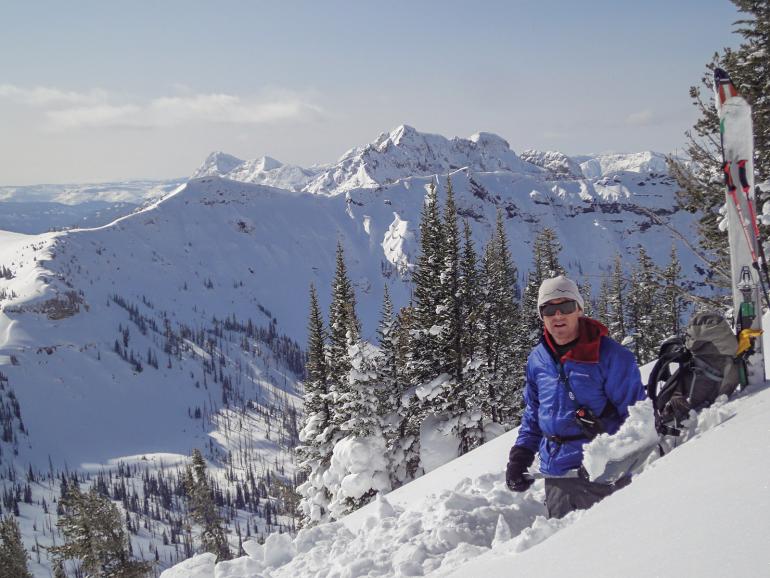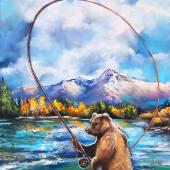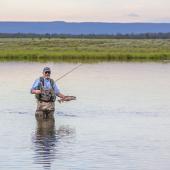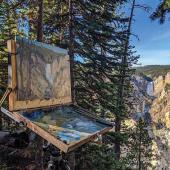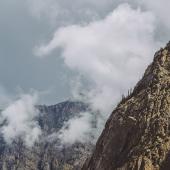My First Time: Doug Chabot
Digging deep with the GNFAC director.
Doug Chabot moved to Bozeman in 1986. He was following a girl, but also looking for a place to live with nearby ice climbing. It all worked out—he got the girl and found the ice. Doug learned to ski only after moving to Bozeman, while simultaneously working as a ski patroller. He speculates that he is the only ski patroller in history to have taken lessons while working.
In 1995, the Gallatin National Forest Avalanche Center (GNFAC) director Karl Birkeland asked Doug to work for him part-time. Karl’s current part-time worker—Alex Lowe—was going on an expedition, and someone needed to fill in. Doug leapt at the opportunity. Alex went on to build his career as a professional climber, and Doug stuck with the avalanche center, becoming director in 2000.
In the ensuing years, Doug has worked tirelessly to make observations, deliver forecasts, and keep Bozeman’s skiers safe in the backcountry. But backcountry skiing has inherent risks, and sometimes, avalanche victims pay the ultimate price.
As Karl and I were taking measurements for the accident report, the other two riders came over. We could feel the pain and hopelessness they experienced that day. It was the first time I had felt the heaviness of death. —Doug Chabot
Part of the job as an avalanche forecaster is looking into these incidents, figuring out what went wrong, and using that information to continually build knowledge of how to stay safe in the backcountry. It’s a process Doug has experienced many times.
Doug, tell us about your first investigation into an avalanche fatality.
It was February 25, 1996. A snowmobiler was killed outside of West Yellowstone, in the Lionhead area. I went with Karl Birkeland on a two-seater touring sled, and we got to the site—miraculously.
I’d seen avalanches before, but I hadn’t seen avalanches that killed people. And this was a large avalanche—it broke five feet deep, 600 feet wide, and slid 800 feet down. It took out a group of three riders; they were all on the slope at the same time. Two of them threaded the needle through some trees—one buried to his chest, the other to his neck. And they lived.
The third got slammed into the trees. A search & rescue crew found him the next day with a metal detector; he wasn’t wearing a beacon. They found the sled and dug it out—and underneath it, was him.
I love the snow. I love avalanches. Yet here was my first taste of their destructive power. It was a big avalanche. The debris was 20 feet deep, and it had broken off tree branches 18 feet high. It was humbling. I remember looking at the hole that the rescuers had dug. And I’ll never forget, the hole was just huge.
And that really drove it home. As Karl and I were taking measurements for the accident report, the other two riders came over. We could feel the pain and hopelessness they experienced that day. It was the first time I had felt the heaviness of death—the affect on partners, friends, family, and children was devastating. That avalanche created a before-and-after point for all of them; a lifelong marker of what could have been.
What if it was me there, on a sunny afternoon after it had snowed 15 inches? Would I have said, “Hey, I don’t think we should be doing this?” Or would I have said, “Yeah, we’re looking good!” —Doug Chabot
But also, I’m fascinated by the power of the snow. And it was cool to look at a crown, dig a hole, and try to piece it together. What exactly happened? What clues are there?
As in most cases, there was an obvious weak layer that was triggered, and it propagated across the slope. And it really showed me that with some investigation, we can learn a lot about what happened, and use that to keep other people safe—as well as myself.
But that was the first time, with an avalanche, where I was seriously playing the what if? game. What if it was me there, on a sunny afternoon after it had snowed 15 inches? Would I have said, “Hey, I don’t think we should be doing this?” Or would I have said, “Yeah, we’re looking good!”
I don’t have clear answers, but ever since then, I’ve always asked that. What if it was me?



